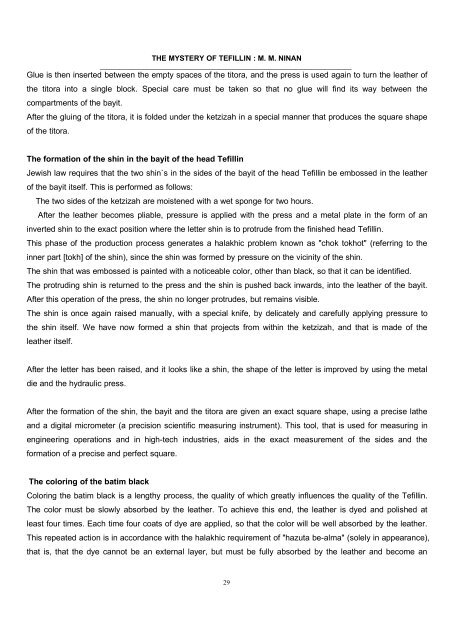Create successful ePaper yourself
Turn your PDF publications into a flip-book with our unique Google optimized e-Paper software.
THE MYSTERY OF TEFILLIN : M. M. NINAN<br />
____________________________________________________________________________<br />
Glue is then inserted between the empty spaces <strong>of</strong> the titora, and the press is used again to turn the leather <strong>of</strong><br />
the titora into a single block. Special care must be taken so that no glue will find its way between the<br />
compartments <strong>of</strong> the bayit.<br />
After the gluing <strong>of</strong> the titora, it is folded under the ketzizah in a special manner that produces the square shape<br />
<strong>of</strong> the titora.<br />
<strong>The</strong> formation <strong>of</strong> the shin in the bayit <strong>of</strong> the head Tefillin<br />
Jewish law requires that the two shin`s in the sides <strong>of</strong> the bayit <strong>of</strong> the head Tefillin be embossed in the leather<br />
<strong>of</strong> the bayit itself. This is performed as follows:<br />
<strong>The</strong> two sides <strong>of</strong> the ketzizah are moistened with a wet sponge for two hours.<br />
After the leather becomes pliable, pressure is applied with the press and a metal plate in the form <strong>of</strong> an<br />
inverted shin to the exact position where the letter shin is to protrude from the finished head Tefillin.<br />
This phase <strong>of</strong> the production process generates a halakhic problem known as "chok tokhot" (referring to the<br />
inner part [tokh] <strong>of</strong> the shin), since the shin was formed by pressure on the vicinity <strong>of</strong> the shin.<br />
<strong>The</strong> shin that was embossed is painted with a noticeable color, other than black, so that it can be identified.<br />
<strong>The</strong> protruding shin is returned to the press and the shin is pushed back inwards, into the leather <strong>of</strong> the bayit.<br />
After this operation <strong>of</strong> the press, the shin no longer protrudes, but remains visible.<br />
<strong>The</strong> shin is once again raised manually, with a special knife, by delicately and carefully applying pressure to<br />
the shin itself. We have now formed a shin that projects from within the ketzizah, and that is made <strong>of</strong> the<br />
leather itself.<br />
After the letter has been raised, and it looks like a shin, the shape <strong>of</strong> the letter is improved by using the metal<br />
die and the hydraulic press.<br />
After the formation <strong>of</strong> the shin, the bayit and the titora are given an exact square shape, using a precise lathe<br />
and a digital micrometer (a precision scientific measuring instrument). This tool, that is used for measuring in<br />
engineering operations and in high-tech industries, aids in the exact measurement <strong>of</strong> the sides and the<br />
formation <strong>of</strong> a precise and perfect square.<br />
<strong>The</strong> coloring <strong>of</strong> the batim black<br />
Coloring the batim black is a lengthy process, the quality <strong>of</strong> which greatly influences the quality <strong>of</strong> the Tefillin.<br />
<strong>The</strong> color must be slowly absorbed by the leather. To achieve this end, the leather is dyed and polished at<br />
least four times. Each time four coats <strong>of</strong> dye are applied, so that the color will be well absorbed by the leather.<br />
This repeated action is in accordance with the halakhic requirement <strong>of</strong> "hazuta be-alma" (solely in appearance),<br />
that is, that the dye cannot be an external layer, but must be fully absorbed by the leather and become an<br />
29


















